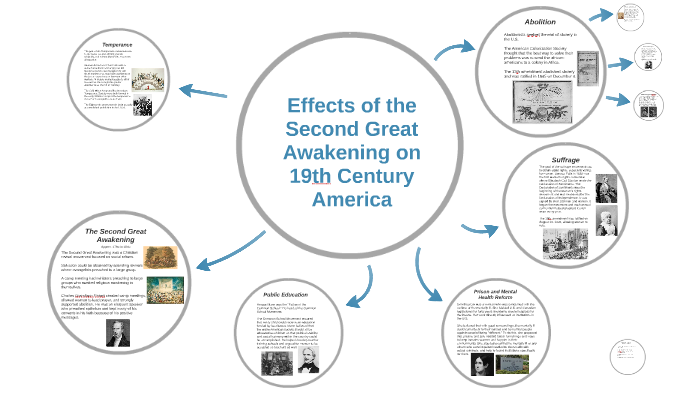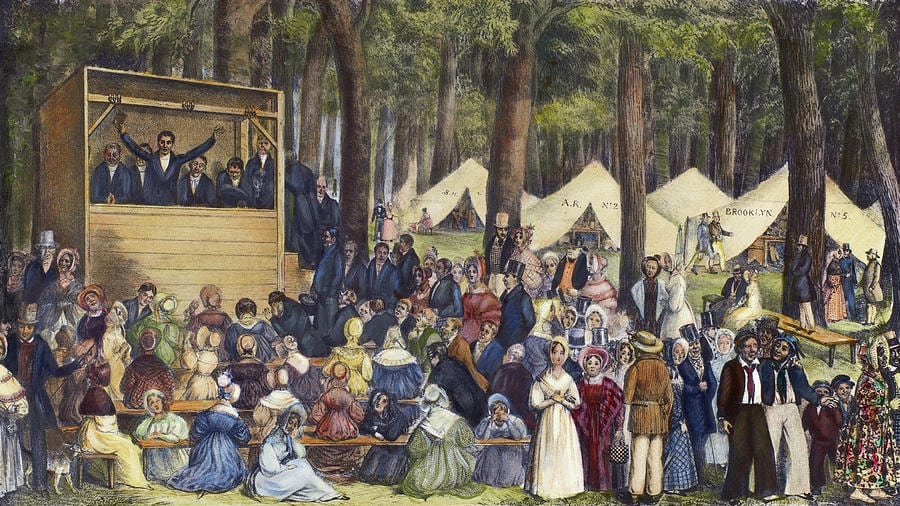How Did the Second Great Awakening Impact Slavery
For both reasons northern anti-slavery sentiment. The Second Great Awakening began just before the turn of the century in the churches of New England especially among Baptists and Methodists.

Effects Of The Second Great Awakening On 19th By Chris Carlsen
HOW DID THIS AFFECT THE ISSUE OF SLAVERY AND THE CIVIL WAR.

. Second Great Awakening Protestant religious revival in the United States from about 1795 to 1835. While the First Great Awakening focused on the conversion of individuals the Second Great Awakening had broader aims. The religious revivals known as the Great Awakening and the Second Great Awakening swept through both the North and South periodically from the 1740s through the 1780s.
The Second Great Awakening had several significant consequences. It is also during this time that we see the precursor to the Feminist movement. Many churches experienced a great increase in membership particularly among Methodist and Baptist churches.
Religious reform affected all of the nation however only in northern states did the reform later play a significant role in social reform. Out of the religious fervor many were inspired to purify the country. Up to 24 cash back THE SECOND GREAT AWAKENING.
The second great awakening affected slavery by churches splitting because some churches splited because. The result of the religion american women mostly north became involved in numerous reforms efforts including temperance the abolition of slavery the colonization of former slaves and important of poisons. Up to 24 cash back Great Awakening.
Women had participated outstanding in the religious revivals known the second Great Awakening and the swept across the floor. In the last video in this series Kim discusses some of the new religious movements and reform movements that grew out of the Second Great Awakening. Finney believed the gospel did not just get people saved but it was also a means of cleaning up society.
It emphasized emotion and enthusiasm but also democracy. During this revival meetings were held in small towns and large cities throughout the country and the unique frontier institution known as the camp meeting began. With prominent evangelicals fighting to give religious rights to African Americans indentured or not the antislavery movement was making its way to the surface and society.
The Second Great Awakening which spread religion through revivals and emotional preaching sparked a number of reform movements. The Second Great Awakening was loosely defined as a new mode of religious authority by ministers who fearful of losing their traditional role of New England society tried to tame the. The Second Great Awakening moved American evangelicals to proselytize at home and abroad.
For example many preachers during the Second Great Awakening decried slavery and alcohol. The image on this lifetime membership certificate to a missionary society shows how the new members money will be used. Both these messages led to the Abolitionist and Temperance Movement of which women were active participants.
The Second Great Awakening also accelerated the growth of different sects and denominations. Abolitionists began to demand immediate uncompensated emancipation of. In New England the renewed interest in religion inspired a wave of social activism.
Revivals were a key part of the movement and attracted hundreds of converts to new Protestant denominations. The guiding hand of Providence and an angel bearing a book presumably a Bible hover at the top of the image. Finney himself was a strong abolitionist and encouraged Christians to become involved in the antislavery movement.
Anthony were denied the right to participate just because of their genders. First it provided the spark for the 19th reform movements that swept across the country. It helped create a broad popular acceptance of the idea that men and women could belong to different Protestant churches and still be committed to essentially the same Christian faith.
Up to 24 cash back The way of life in which slavery was the center of was being challenged and this was based entirely on the morality that the Great Awakening helped spread throughout the colonies. Up to 24 cash back Abolitionist Movement. Up to 24 cash back Slavery During the Great Awakening.
How did the Second Great Awakening affect slavery. The Second Great Awakening played a role in major reform movements of the nineteenth century including temperance and abolition. The Second Great Awakening was a religious revival movement during the 19th century that was challenging womens traditional roles in religion.
During the Second Great Awakening many Christians began to speak out forcefully against slavery which they considered to be a sin. The Second Great Awakening was a religious revival movement in the first half of the 19th century. Second Great Awakening Change and Results.
At the age of seventy-five. Many northerners opposed slavery on moral grounds but others simply wanted to stop the spread of slavery in order to gain political advantage. The Abolitionist Movement or the freedom of slaves had roots in the Second Great Awakening.
The Second Great Awakening. New religious denominations emerged that restructured churches to allow for more people involved in leadership an emphasis on mans equality before god and personal relationships. With the ideas of the Second Great.
Americans especially women became active in reform movements in anti-slavery temperance moral and prison reform aid to the poor and the care for the insane. In western New York the spirit of revival encouraged the emergence of new denominations. Up to 24 cash back The Second Great Awakening consisted of many forms of religious revivals and religious reform groups offering salvation for all.
In order to do this. Seeking to perfect society adherents targeted slavery as an evil that destroyed individual free will as moral beings. This Second Great Awakening consisted of several kinds of activity distinguished by locale and expression of religious commitment.
Particularly in the Baptist Church African Americans were welcomed as members and as preachers. During the early nineteenth century a religious revival swept across Kentucky Tennessee and Ohio. In the Appalachian region of Kentucky.
Historians believe ideas set forth during the religious movement known as the Second Great Awakening inspired abolitionists to rise up against slavery. The goal was to bring about a Christian America. Lyman Beecher never tired of fighting for the establishment of Christs kingdom on earth.
These women not only became motivated to fight for the rights of slaves but also for their own since human freedom was one of the essential ideas of the Second Great Awakening. This is the currently selected item. Education womens rights and the abolition of slavery among many others.
Religious revivals during the Second Great Awakening intensified anti-slavery activity after 1830. He and his followers worked to make the United States a Christian nation. Important figures and groups.
The Second Great Awakening was a Protestant religious revival during the early 19th century in the United States. It fueled the womens rights movement the abolitionist movement and the temperance movement alike three events that are. Early Baptist assemblies were shaped by slaves and free African Americans in South Carolina and Virginia.
During the international anti-slavery convention Elizabeth Cady Stanton and Susan B.

2nd Great Awakening For Apush Simple Easy Direct

Collections Why Did The Second Great Awakening Inspire Reform Movements Smithsonian Learning Lab

The Second Great Awakening Reform And Religious Movements Video Khan Academy

No comments for "How Did the Second Great Awakening Impact Slavery"
Post a Comment